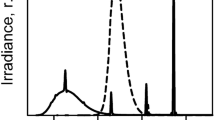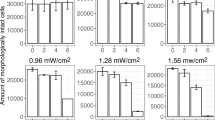Abstract
In the Baltic Sea, two co-occurring green macroalgae Cladophora sp. and Ulva intestinalis grow in the upper eulittoral. Due to regular and high sunlight exposure in their habitat, both species need resistance mechanisms to protect themselves against ultraviolet-B (UV-B)-induced DNA damage. While Cladophora sp. possesses efficient screening of UV-B and ultraviolet-A (UV-A) radiation, U. intestinalis was recently shown to have higher DNA repair by UVA-driven photoreactivation than Cladophora sp. [F. Pescheck and W. Bilger, Mar. Biol., 2018, 165, 132]. In the present study, the hypothesis that the screening of UV-A radiation limits internal UV-A availability for photoreactivation in Cladophora sp. was tested. Both species had identical and much lower fractions of damaged DNA when sampled in situ under direct sunlight as expected based on a photo-physical prediction. To quantify the effect of UV-A screening spectrally and physiologically, in vivo UV screening spectra were determined and the UV-A photon flux dependency of photoreactivation was investigated for both species. Identical intrinsic photoreactivation rates were revealed by the applied correction for internal UV-A photon flux density and under irradiation with visible radiation which is not screened by the UV absorbing compounds in Cladophora sp. Natural sunlight was weighted with in vivo action spectra for DNA damage induction and light-dependent repair. The resulting spectrum was further corrected for the apparent UV screening spectra of both species to calculate the species-specific internal ratios of DNA damaging and photoreactivating photons. This photophysical modelling improves the understanding of UV damage and tolerance mechanisms in the two co-occurring green macroalgae under solar irradiation.
Similar content being viewed by others
References
I. Vass, A. Szilard and C. Sicora, in, Handbook of photosynthesis, ed. M. Pessaraki, Marcel Dekker Inc., New York, 2nd edn, 2005, pp. 827–843.
A. B. Britt, Repair of DNA damage induced by solar UV, Photosynth. Res., 2004, 81, 105–112.
D. Verdaguer, M. A. K. Jansen, L. Llorens, L. O. Morales and S. Neugart, UV-A radiation effects on higher plants: Exploring the known unknown, Plant Sci., 2017, 255, 72–81.
J. Cadet, S. Mouret, J.-L. Ravanat and T. Douki, Photoinduced damage to cellular DNA: direct and photosensitized reactions, Photochem. Photobiol., 2012, 88, 1048–1065.
F. E. Quaite, B. M. Sutherland and J. C. Sutherland, Action spectrum for DNA damage in Alfalfa lowers predicted impact of ozone depletion, Nature, 1992, 358, 576–578.
W. H. van de Poll, D. Hanelt, K. Hoyer, A. G. J. Buma and A. M. Breeman, Ultraviolet-B-induced cyclobutane-pyrimidine dimer formation and repair in arctic marine macrophytes, Photochem. Photobiol., 2002, 76, 493–500.
K. Malhotra, S. Kim and A. Sancar, Characterization of a medium wavelength type DNA photolyase - Purification and properties of photolyase from, Bacillus firmus, Biochemistry, 1994, 33, 8712–8718.
A. Sancar, Structure and function of DNA photolyase and cryptochrome blue-light photoreceptors, Chem. Rev., 2003, 103, 2203–2237.
E. Cocquyt, H. Verbruggen, F. Leliaert and O. De Clerck, Evolution and cytological diversification of the green seaweeds (Ulvophyceae), Mol. Biol. Evol., 2010, 27, 2052–2061.
S. Kiontke, P. Gnau, R. Haselsberger, A. Batschauer and L.-O. Essen, Structural and evolutionary aspects of antenna chromophore usage by class II photolyases, J. Biol. Chem., 2014, 289, 19659–19669.
Y. Takeuchi, M. Murakami, N. Nakajima, N. Kondo and O. Nikaido, The photorepair and photoisomerisation of DNA lesions in etiolated cucumber cotyledons after irradiation by UV-B depends on wavelength, Plant Cell Physiol., 1998, 39, 745–750.
A.-L. Dany, T. Douki, C. Triantaphylides and J. Cadet, Repair of the main UV-induced thymine dimeric lesions within, Arabidopsis thaliana DNA: evidence for the major involvement of photoreactivation pathways, J. Photochem. Photobiol. B, 2001, 65, 127–135.
L. A. Díaz-Ramos, A. O’Hara, S. Kanagarajan, D. Farkas, Å. Strid and G. I. Jenkins, Difference in the action spectra for UVR8 monomerisation and HY5 transcript accumulation in Arabidopsis, Photochem. Photobiol. Sci., 2018, 17, 1108–1117.
G. Agati, G. Stefano, S. Biricolti and M. Tattini, Mesophyll distribution of “antioxidant” flavonoid glycosides in, Ligustrum vulgare leaves under contrasting sunlight irradiance, Ann. Bot., 2009, 104, 853–861.
W. Bilger, L. Schreiber and U. Schreiber, Measurement of leaf epidermal transmittance of UV-radiation by chlorophyll fluorescence, Physiol. Plant., 1997, 101, 754–763.
G. Agati, Z. G. Cerovic, P. Pinelli and M. Tattini, Light-induced accumulation of ortho-dihydroxylated flavonoids as non-destructively monitored by chlorophyll fluorescence excitation techniques, Environ. Exp. Bot., 2011, 73, 3–9.
H. Hada, J. Hidema, M. Maekawa and T. Kumagai, Higher amounts of anthocyanins and UV-absorbing compounds effectively lowered CPD photorepair in purple rice (Oryza sativa L.), Plant, Cell Environ., 2003, 26, 1691–1701.
H. S. Kang, J. Hidema and T. Kumagai, Effects of light environment during culture on UV-induced cyclobutyl pyrimidine dimers and their photorepair in rice (Oryza sativa L.), Photochem. Photobiol., 1998, 68, 71–77.
R. Schmitz-Hoerner and G. Weissenböck, Contribution of phenolic compounds to the UV-B screening capacity of developing barley primary leaves in relation to DNA damage and repair under elevated UV-B levels, Phytochemistry, 2003, 64, 243–255.
F. Garcia-Pichel and R. W. Castenholz, Occurrence of UV-absorbing, mycosporine-like compounds among cyanobacterial isolates and an estimate of their screening capacity, Appl. Environ. Microbiol., 1993, 59, 163–169.
W. H. van de Poll, A. Eggert, A. G. J. Buma and A. M. Breeman, Effects of UV-B-induced DNA damage and photoinhibition on growth of temperate marine red macrophytes: Habitat-related differences in UV-B tolerance, J. Phycol., 2001, 37, 30–37.
E. Pérez-Rodríguez, J. Aguilera and F. L. Figueroa, Tissular localization of coumarins in the green alga, Dasycladus vermicularis (Scopoli) Krasser: a photoprotective role?, J. Exp. Bot., 2003, 54, 1093–1100.
F. Pescheck, K. Bischof and W. Bilger, Screening of ultra-violet-A and ultraviolet-B radiation in marine green macro-algae (Chlorophyta), J. Phycol., 2010, 46, 444–455.
F. Pescheck and W. Bilger, Compensation of lack of UV screening by cellular tolerance in green macroalgae (Ulvophyceae) from the upper eulittoral, Mar. Biol., 2018, 165, 132.
F. Pescheck, K. T. Lohbeck, M. Y. Roleda and W. Bilger, UVB-induced DNA and photosystem II damage in two intertidal green macroalgae: distinct survival strategies in UV-screening and non-screening Chlorophyta, J. Photochem. Photobiol., B, 2014, 132, 85–93.
K. Bischof, I. Gómez, M. Molis, D. Hanelt, U. Karsten, U. Lüder, M. Roleda, K. Zacher and C. Wiencke, Ultraviolet radiation shapes seaweed communities, Rev. Environ. Sci. Bio/Technol., 2006, 5, 141–166.
F. Pescheck, H. Campen, L. Nichelmann and W. Bilger, Relative sensitivity of DNA and photosystem II in, Ulva intestinalis (Chlorophyta) under natural solar irradiation, Mar. Ecol.: Prog. Ser., 2016, 555, 95–107.
K. Bischof, G. Peralta, G. Kräbs, W. H. van de Poll, J. L. Pérez-Lloréns and A. M. Breeman, Effects of solar UV-B radiation on canopy structure of Ulva communities from southern Spain, J. Exp. Bot., 2002, 53, 2411–2421.
A. Britt and E. L. Fiscus, Growth responses of Arabidopsis DNA repair mutants to solar irradiation, Physiol. Plant., 2003, 118, 183–192.
E. L. Fiscus, R. Philbeck, A. B. Britt and F. L. Booker, Growth of Arabidopsis flavonoid mutants under solar radiation and UV filters, Environ. Exp. Bot., 1999, 41, 231–245.
J. Hidema, T. Taguchi, T. Ono, M. Teranishi, K. Yamamoto and T. Kumagai, Increase in CPD photolyase activity functions effectively to prevent growth inhibition caused by UVB radiation, Plant J., 2007, 50, 70–79.
W. M. Waterworth, O. Jiang, C. E. West, M. Nikaido and C. M. Bray, Characterization of Arabidopsis photolyase enzymes and analysis of their role in protection from ultra-violet-B radiation, J. Exp. Bot., 2002, 53, 1005–1015.
Q. S. Pang and J. B. Hays, UV-B-inducible and temperature-sensitive photoreactivation of cyclobutane pyrimidine dimers in, Arabidopsis thaliana, Plant Physiol., 1991, 95, 536–543.
L. Provasoli, in, Cultures and collections of algae, ed. A. Watanabe and A. Hattori, Japanese Society of Plant Physiology, Tokyo, 1968, pp. 47–74.
F. Pescheck and W. Bilger, High impact of seasonal temperature changes on acclimation of photoprotection and radiation-induced damage in field grown, Arabidopsis thaliana, Plant Physiol. Biochem., 2019, 134, 129–136.
L. Nichelmann and W. Bilger, Quantification of light screening by anthocyanins in leaves of, Berberis thunbergii, Planta, 2017, 246, 1069–1082.
M. Veit, W. Bilger, T. Mühlbauer, W. Brummet and K. Winter, Diurnal changes in flavonoids, J. Plant Physiol., 1996, 148, 478–482.
C. Musil, Differential effects of elevated ultraviolet-B radiation on the photochemical and reproductive performances of dicotyledonous and monocotyledonous arid environment ephemerals, Plant, Cell Environ., 1995, 18, 844–854.
L. Guidi, C. Brunetti, A. Fini, G. Agati, F. Ferrini, A. Gori and M. Tattini, UV radiation promotes flavonoid biosynthesis, while negatively affecting the biosynthesis and the de-epoxidation of xanthophylls: Consequence for photoprotection?, Environ. Exp. Bot., 2016, 127, 14–25.
G. Payne, M. Wills, C. Walsh and A. Sancar, Reconstitution of Escherichia coli photolyase with flavins and flavin analogs, Biochemistry, 1990, 29, 5706–5711.
P. F. Heelis, R. F. Hartman and S. D. Rose, Photoenzymic repair of UV-damaged DNA: a chemist’s perspective, Chem. Soc. Rev., 1995, 24, 289–297.
S. T. Kim and A. Sancar, Effect of base, pentose, and phos-phodiester backbone structures on binding and repair of pyrimidine dimers by, Escherichia coli DNA photolyase, Biochemistry, 1991, 30, 8623–8630.
Y. S. Han, S. H. Kang and T. Han, Photosynthesis and photoinhibition of two green macroalgae with contrasting habitats, J. Plant Biol., 2007, 50, 410–416.
Y. Takeuchi, M. Murakami, N. Nakajima, N. Kondo and O. Nikaido, Induction and repair of damage to DNA in cucumber cotyledons irradiated with UV-B, Plant Cell Physiol., 1996, 37, 181–187.
S. J. Britz and W. R. Briggs, Circadian rhythms of chloro-plast orientation and photosynthetic capacity in, Ulva, Plant Physiol., 1976, 58, 22–27.
Z. G. Cerovic, G. Samson, F. Morales, N. Tremblay and I. Moya, Ultraviolet-induced fluorescence for plant monitoring: present state and prospects, Agronomie, 1999, 19, 543–578.
D. Karentz, J. E. Cleaver and D. L. Mitchell, Cell survival characteristics and molecular responses of Antarctic phyto-plankton to ultraviolet-B radiation, J. Phycol., 1991, 27, 326–341.
K. Iwabuchi, J. Hidema, K. Tamura, S. Takagi and I. Hara-Nishimura, Plant nuclei move to escape ultraviolet-induced DNA damage and cell death, Plant Physiol., 2016, 170, 678–685.
T. Douki, A. Reynaud-Angelin, J. Cadet and E. Sage, Bipyrimidine photoproducts rather than oxidative lesions are the main type of DNA damage involved in the genotoxic effect of solar UVA radiation, Biochemistry, 2003, 42, 9221–9226.
Author information
Authors and Affiliations
Corresponding author
Additional information
Electronic supplementary information (ESI) available. See DOI: 10.1039/c8pp00432c
Rights and permissions
About this article
Cite this article
Pescheck, F. UV-A screening in Cladophora sp. lowers internal UV-A availability and photoreactivation as compared to non-UV screening in Ulva intestinalis. Photochem Photobiol Sci 18, 413–423 (2019). https://doi.org/10.1039/c8pp00432c
Received:
Accepted:
Published:
Issue Date:
DOI: https://doi.org/10.1039/c8pp00432c




